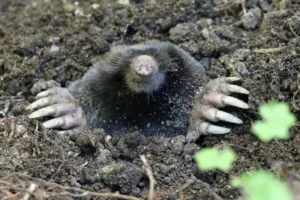
It has happened to all of us. We go walking through the yard and step into a carved-out hole or tunnel in the ground that almost breaks our ankle. But knowing what animal that has created this newfound creation in our yard can be tough to diagnose. Cindy Decker, a columnist for The Columbus Dispatch (Ohio) shared some of her garden expertise to help identify what animal might be digging around the house.
What Is Digging Holes In My Yard?
The sizes, shapes and locations of animal holes all tell a tale.
Some excavations signify a search for food; others speak to homebuilding.
To learn how to identify the source of backyard digging, I turned to Adam Turpen, director of SCRAM! Wildlife Control, the arm of the Ohio Wildlife Center that offers humane wildlife solutions.
Moles
Moles can be obvious in the lawn, leaving serpentine raised tunnels through which they travel and feed.
Although the look isn’t pleasing, Turpen said, “These animals are aerating the lawn.”
The entrance to the tunnel is a quarter-sized hole.
If you have moles, you have tasty things in the soil. Moles eat earthworms and grubs.
Turpen and others recommend treating the lawn for grubs to help control moles.
The Purdue University Extension warns, though, that the method isn’t foolproof because other food sources remain.
Chipmunks
When digging in the garden, chipmunks are looking for food, maybe some seeds or a flower bulb.
Those holes will be fairly shallow.
When they burrow, chipmunks can create extensive tunnel systems. The entrance hole, Turpen said, is about the size of a 50-cent piece — a clean hole without a lot of dirt around it.
Chipmunks like to burrow under sidewalks, next to houses and sheds, and along root systems of trees.
According to the Humane Society of the United States, chipmunks don’t generally damage property.
Skunks
Skunks digging for food leave conical holes about 3 inches deep, as if a pencil were stuck in the earth and then swirled around, Turpen said.
Their burrows have entrances about the size of a grapefruit, he said.
“You’d generally see pebbles build up around the front.”
Skunks often dig under decks, sheds and porches.
Raccoons
Raccoons dig holes similar to those of skunks but perhaps slightly larger.
Hair caught on branches near a hole might help identify the creature using it.
When raccoons forage for food in a lawn, Turpen said, it will look as if someone has rolled back the sod.
Groundhogs
Groundhog holes are larger and deeper than others — sometimes the size of a soccer ball, Turpen said — with
earth mounded at the entrance.
Other animals, such as red foxes, sometimes take over groundhog holes.
“They are the ones who generally do the work,” he said.
Burrows might — but don’t always — have multiple entrances and exits.
Cindy Decker, At Home editor, writes about native gardening and living with wildlife.